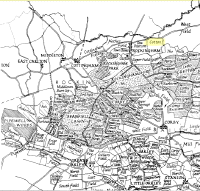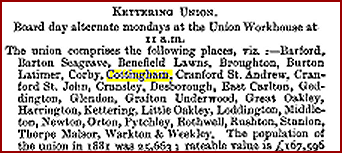
17th Century map, reproduced by
permission of the Record Society

Extract from Kelly's Directory, 1890 |
Up until the
dissolution of the monasteries in 1543, the poor and sick were looked after by
religious establishments. There were at least three hospitals for lepers in
Rockingham Forest, one, dedicated to St Leonard, located at a place called
'Cotes' or 'Coton' off the Rockingham to Gretton Road, shown on the
17th Century map opposite (OS map grid reference
SP876926).
Today,
the
first turning off Gretton Road on the right, as you head from Rockingham, is
called 'The Cottons', named after Coton.
Some historical directories, including
Kelly's, refer to this lepers' hospital as being in Cottingham. However, in his
book 'Rockingham Forest Revisited', Peter Hill says that this is an error, and
that Cottingham is a misreading of Coton.
In 1601, the Poor Law
came into being, making each parish responsible for the upkeep of its poor
(including destitute single mothers) by means of a rate levied on the village
that would be used, in many cases, to build poorhouses or almshouses. There were
almshouses in Corby, East Carlton and Rockingham.
In 1834, Poor Law Unions were set up representing
several communities to build centralised workhouses. Cottingham was
under the wing of the Kettering Union Workhouse, built in 1837 to accommodate
250 inmates (see extract from Kelly's Directory opposite). The building later
became St Mary's Hospital on London Road.
I have also been told that Cannam House in Middleton
used to be a workhouse, but I haven't been able to verify this. |
|
Well-off villagers sometimes recognised the poor in
their wills. Kelly's Directory tells us that William Downhall's will (1760) left the rent of 18 acres to
the poor of Cottingham and Middleton. In the 1870s, this land produced £30 which
was chiefly distributed in fuel. There is a wooden board at the belfry end of
St Mary Magdalene with the will of William Downhall.
Kelly's also mentions
that William Riddle left the rent of 1 acre, 1
rood and 39 perches for apprenticing poor children. By 1914, this amounted to £3
10s a year. William also left 'small sums at interest for the benefit of the
poor'.
In her will (1835) Mary Aldwinckle left
£10 to the church wardens to distribute amongst the poor on Christmas Day
following her decease, and £40 to "place out four poor boys belonging to the
parish of Cottingham as apprentices" giving the church wardens discretion to
choose the best trade for the boys' advantage and future prospects.
back to top of
page
|